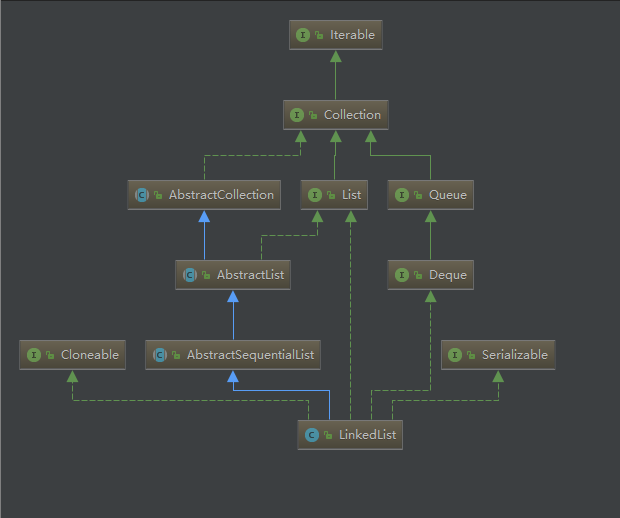LinkedList简介
LinkedList是一个使用双向链表结构实现的容器,与ArrayList一样,它能动态扩充其长度,LinkedList相较于ArrayList,其任意位置插入速度比ArrayList要快,但是其查询速度要比ArrayList要慢;LinkedList继承自AbstractSequentialList,实现了List、Deque、Cloneable、Serializable接口。
LinkedList UML图如下:

和ArrayList一样,LinkedList也不是一个线程安全的容器。
LinkedList源码分析
构造方法
LinkedList有两个构造方法:
public LinkedList() {
}
//从已有的一个容器创建一个LinkedList对象
public LinkedList(Collection extends E> c) {
this();
addAll(c);
}
addAll()方法:
public boolean addAll(Collection extends E> c) {
return addAll(size, c);
}
public boolean addAll(int index, Collection extends E> c) {
//检查index是否溢出
checkPositionIndex(index);
Object[] a = c.toArray();
int numNew = a.length;
if (numNew == 0)
return false;
//获取第index位置的node元素和node的前一个元素
//succ:第index位置的node元素
//pred:index位置前一个node元素
Node pred, succ;
if (index == size) {
succ = null;
pred = last;
} else {
succ = node(index);
pred = succ.prev;
}
//遍历,将元素插入链表中
for (Object o : a) {
@SuppressWarnings("unchecked") E e = (E) o;
Node newNode = new Node<>(pred, e, null);
if (pred == null)
first = newNode;
else
pred.next = newNode;
pred = newNode;
}
if (succ == null) {
last = pred;
} else {
pred.next = succ;
succ.prev = pred;
}
size += numNew;
modCount++;
return true;
}
add方法
LinkedList也有两个add方法,如下:
public boolean add(E e) {
//添加元素到队尾
linkLast(e);
return true;
}
public void add(int index, E element) {
//检查index是否溢出
checkPositionIndex(index);
if (index == size)
//index == size,直接添加到队尾
linkLast(element);
else
//index != size,添加元素到index位置
linkBefore(element, node(index));
}
linkLast方法:
void linkLast(E e) {
final Node l = last;
//新建一个node,将其前一个元素指针指向原链表的最后一个元素
final Node newNode = new Node<>(l, e, null);
//更新尾指针
last = newNode;
if (l == null)
//若原last==null说明此时链表就一个元素
first = newNode;
else
//更新原链表尾元素指针
l.next = newNode;
size++;
modCount++;
}
linkBefore方法:
void linkBefore(E e, Node succ) {
// assert succ != null;
//获取指定位node元素的前一个元素pred
final Node pred = succ.prev;
//新建一个node,将其前指针指向pred元素
final Node newNode = new Node<>(pred, e, succ);
//将指定位置的node元素的前指针指向新元素,完成插入
succ.prev = newNode;
if (pred == null)
first = newNode;
else
pred.next = newNode;
size++;
modCount++;
}
获取指定位置node指针方法node:
Node node(int index) {
// assert isElementIndex(index);
//index > size/2时,说明在链表前半段,从前往后搜索
if (index < (size >> 1)) {
Node x = first;
for (int i = 0; i < index; i++)
x = x.next;
return x;
//index < size/2时,从后往前搜索
} else {
Node x = last;
for (int i = size - 1; i > index; i--)
x = x.prev;
return x;
}
}
get方法也比较简单,首先检测index是否溢出,然后直接找到index位置的元素,并返回其item。
以上就是本文的全部内容,希望对大家的学习有所帮助,也希望大家多多支持脚本之家。





















 181
181











 被折叠的 条评论
为什么被折叠?
被折叠的 条评论
为什么被折叠?








